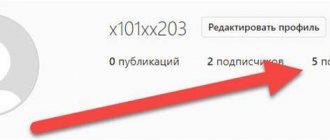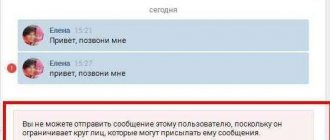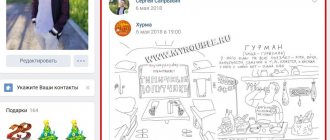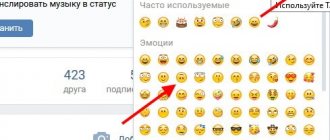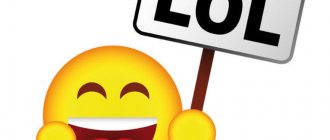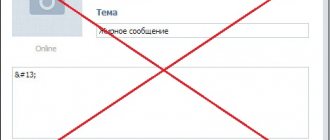Some people think that it is not at all necessary to use emoticons when correspondence, and for some it even outright infuriates them. However, to deny that they have firmly entered our lives is frankly stupid. I will give several examples from life demonstrating this.
One of my friends, who actively uses various Internet messengers, such as WhatsApp, Telegram and chats on social networks, once shared her problem in a heart-to-heart conversation: her young boyfriend does not use emoticons at all! Without them, she could not understand where he was joking and where he was being serious. This created big problems in communication and constantly led to scandal. She was seriously afraid that this would all lead to a break in the relationship. In the end, everything ended well. He started using emoticons, she began to understand him better and not worry that he was making fun of her, in short, a happy ending.
The second conversation, with another friend, was not on the topic of emoticons, but briefly touched on this topic. She also shared her observations. Due to the nature of her activity, she communicates with many people, both in correspondence and in person. And so, in her opinion, it is simply impossible for many people to communicate without emoticons. In life, they cannot connect even two words, and when you read their messages, generously strewn with different faces, it becomes very clear what they want to say. This is an interesting observation.
Of course, there are a lot of haters who consider all these “yellow heads” absolutely unnecessary and even harmful, but the distribution throughout the world and the great variety of a wide variety of emoticons for all occasions clearly shows that they remain in the minority.
Who invented emoticons and when?
The first emoticons looked very simple.
There are several versions of the appearance of the emoticon. It is alleged that the first of them appeared in the late 50s and early 60s. The author of the very first one is considered to be the American artist Harvey Ball. In 1963, there was great competition between insurance companies, many of them were forced to lay off employees, and in the struggle for clients they were forced to look for non-standard approaches. One company commissioned Harvey to create a positive design that could be pinned to clothing. As planned, this drawing was supposed to give the client positive emotions. In just 10 minutes, the artist came up with such a drawing - it was the first “smile” emoticon. They paid him some 43 dollars for it and parted with the world. Who would have guessed that these pictures would appeal to customers so much? Very soon the company ordered 10,000 of these images!
It is alleged that the first of them appeared in the late 50s and early 60s. The author of the very first one is considered to be the American artist Harvey Ball. In 1963, there was great competition between insurance companies, many of them were forced to lay off employees, and in the struggle for clients they were forced to look for non-standard approaches. One company commissioned Harvey to create a positive design that could be pinned to clothing. As planned, this drawing was supposed to give the client positive emotions. In just 10 minutes, the artist came up with such a drawing - it was the first “smile” emoticon. They paid him some 43 dollars for it and parted with the world. Who would have guessed that these pictures would appeal to customers so much? Very soon the company ordered 10,000 of these images!
The history of the electronic smiley, which began to be used in computer programs, started in 1982. Its authorship is attributed to the American scientist Scott Fahlman from Carnegie Mellon University. On September 19, he proposed putting symbols on the university information board for comic announcements and
Its authorship is attributed to the American scientist Scott Fahlman from Carnegie Mellon University. On September 19, he proposed putting symbols on the university information board for comic announcements and for announcements that were not humorous.
for announcements that were not humorous.
Since then, emoticons have become a part of Internet culture and even, one might say, Internet etiquette. They are present wherever communication takes place, and their number is so huge that you can tell everything you want with just pictures.
Graphic emoticons Emoji (emoji), their codes and meanings
So, above we examined symbolic emoticons, some of which, when inserted on social networks and other places, can acquire graphic outlines, that is, appear in the form of pictures. But this does not happen everywhere and not always. Why?
Yes, because they consist of simple text icons. In order for emoticons to be guaranteed to acquire the appearance of images after insertion, and in any place where you place them, you must use codes specially included in the official Unicode table so that any user can quickly express their emotional state.
Of course, any emoticon can be loaded in the form of pictures created in graphic editors, but given the huge number of them and the number of users on the Internet, such a solution does not seem ideal, since it will inevitably negatively affect the bandwidth of the global network. But the use of codes in this situation is just right.
As a result, popular engines used for forums and blogs (for example, WordPress) have in their functionality the ability to insert colored emoticons, which undoubtedly adds expressiveness to messages.
The same can be said for various chats and instant messengers designed for both PCs and mobile devices (Skype, Telegram, Viber, Whatsapp).
It is graphic pictograms that are called emoji (or emoji, which is more correct from the point of view of Japanese pronunciation). The term "画像文字" (in Latin transliteration "emoji"), which, like kaomoji, is a phrase consisting of two words translated into Russian meaning "picture" ("e") and "letter", "symbol" ( moji).
I think the Japanese name for small pictures that appear in the text to display emotions, feelings and states is most fair, since it was in Japan that symbolic images were born that do not require mentally turning them over for correct perception.
As I noted above, any emoji code in the vast majority of cases is necessarily interpreted into a picture in all possible places where you want to insert it, including, for example, social networks VKontakte, Facebook, Twitter, etc.
Moreover, in different areas, the smiley may be displayed differently when inserting the same Unicode code corresponding to a specific value:
Another important point. By default, the emoji emoticon will be in black and white or displayed as a rectangle (it all depends on the platform that is used where it is inserted). You can verify this if you visit the encoder and try to insert HTML codes corresponding to different emoticons into the field on the right:
Similar emojis will look exactly like this in the browser. In order for them to acquire color, you need to use a special script that is installed on large popular services. By the way, in one of the latest versions of WordPress (I don’t remember which one) emoji were enabled by default, but I had to disable them due to a seriously increased load on the server, which I try to constantly monitor.
So for small businesses with limited resources, emojis are not always a boon. After disabling, when you try to insert emoji into the text of an article or comment, the emoticons will be present in black and white or in the shape of a rectangle.
But in popular social networks, the use of the appropriate HTML code by any user initiates the appearance of a full-fledged emoticon. By the way, in the same Contact there is a whole collection of emoji, sorted into categories. You can copy this or that emoji from the Unicode table, located here, where the icons are distributed in sections:
Decoding the meanings of popular emoticons
Now there is a separate emoticon for each emotion or event. One of my friends told me that he and his friends have a special emoticon - a man in a hat with earflaps, holding a bottle of vodka and playing the balalaika - it means “Hey, guys! I'm not in a good mood today. How about getting together in the evening and chatting in good company with a bottle of vodka and a good snack?” Agree that writing in words takes much longer than sending a symbol. This example is a little specific, because... not all sets have similar images, but the most popular emoticons, known to everyone, are sure to be in any social network. Let's decipher the most popular of them.
| Designation | Other options | Decoding |
 | :-), (:, (-: | Smile |
 | :-(,):, )-: | Sadness |
| :.( | :,( | Tears |
 | XD | Very funny |
| :3 | =3 | Tenderness |
 |  | Wink |
 |  | Seriousness |
| :/ | :\ | Chagrin |
| %) | %( | Shock: in the first case pleasant, in the second - not |
| :.) | :.D | Laughter to tears |
| :R | :-P,=P,:b, :-b, :p | Show tongue |
| :* | :-*, =* | Kiss |
| :-! | :! | Disgust |
| :@ | Scream | |
| :X | :-X, :x | Secret |
This is a set of the most common emoticons, which probably everyone knows and already automatically puts the necessary icons in their messages.
What do text emoticons made up of symbols mean?
Let's continue to study the meanings of the most common spellings of certain emoticons using ordinary (unpretentious) symbols. Ready? Well, then let's go.
Initially, emoticons that appeared to be rotated by ninety degrees became widespread, i.e. lying on their side (see the above examples of laughing and sad faces). Let's see what other combinations you might encounter on the Internet and what they mean (how to decipher them).
Indication of emotions by emoticon symbols
- Joy or a smile is most often depicted using symbols:

